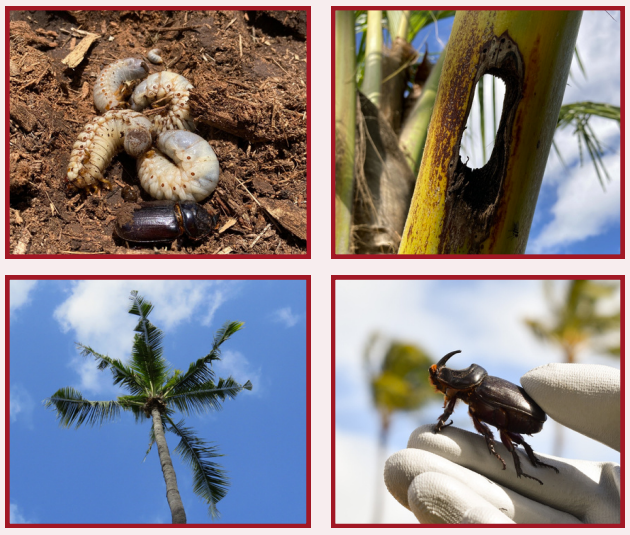7/8/25 – CRB BREEDING SITES FOUND ON HAWAIʻI ISLAND
|
JOSH GREEN, M.D. GOVERNOR |
DAWN CHANG |
CRB BREEDING SITES FOUND ON HAWAIʻI ISLAND
KONA, Hawaiʻi Island – Surveys conducted last week located two breeding sites of coconut rhinoceros beetle (CRB) in Kona, on the west side of Hawaiʻi Island. The detection triggered the launch of a state and county interagency response effort to manage and eradicate the invasive species. Partners include the DLNR, University of Hawaiʻi, Big Island Invasive Species Committee (BIISC), Department of Agriculture and Biosecurity (DAB), and County of Hawaiʻi.
Active management of CRB on Hawaiʻi Island has been ongoing since the first detection in Waikoloa in 2023. In March 2025, an adult beetle was captured by a trap installed at the Ellison Onizuka Kona International Airport, initiating an intensive trapping effort for the surrounding area. To date, 30 adult beetles have been caught, with one beetle trapped as far north as Kiholo Bay.
Recent actions taken to protect west Hawaiʻi and prevent the spread of CRB extend beyond state and county agencies to include residents, local businesses and community organizations. Activities include the removal of green waste and other decaying plant matter ripe for CRB breeding, deploying more traps in the surrounding area, and organizing multiple surveys with scent detection dogs.
Since March, thousands of cubic yards of potential host material have been inspected. So far, only two breeding sites have been found, bringing the Hawaiʻi Island total to three. Treatment for these sites is underway, and detection surveys for other potential breeding sites are ongoing.
To underscore the severity of the impacts this invasive species is capable of, the County of Hawaii and DAB issued a three-month voluntary compliance order to stop the movement of host materials for CRB. The voluntary order is effective through Sept. and applies to the area of west Hawaiʻi where CRB detections have occurred in the last six months.
“Intra-agency collaboration is critical to preventing the invasion and establishment of CRB on the Big Island,” said Parawinder Grewal, Dean of the University of Hawaiʻi College of Tropical Agriculture and Human Resilience. “We must use all our available resources and intellect. Failure is not an option.”
Combined efforts on Hawaiʻi Island have led to the deployment of nearly 400 traps and the treatment of 1,300 palm trees to prevent CRB damage. Public outreach in the Kona area continues, ensuring greater community awareness and engagement going forward.
# # #
RESOURCES
(All images/video Courtesy: DLNR)
Photographs – CRB response efforts (various):
CRB Statewide Communications Plan (2024):
https://dlnr.hawaii.gov/hisc/files/2024/03/Hawaii-CRB-Communications-Plan-2024.pdf
Reports of possible CRB infestation on Hawaiʻi Island may be addressed to 643PEST.org or the state’s toll-free Pest Hotline at (808) 643-PEST (7378).
For more information on CRB, go to the CRB Response webpage: https://www.crbhawaii.org/
For more information on the Voluntary Compliance Order: https://hdoa.hawaii.gov/blog/main/hawaii-island-crb-stop-movement/
Media Contact:
Ryan Aguilar
Communications Specialist
Department of Land and Natural Resources, State of Hawai‘i
Email: [email protected]
Legal Disclaimer:
EIN Presswire provides this news content "as is" without warranty of any kind. We do not accept any responsibility or liability for the accuracy, content, images, videos, licenses, completeness, legality, or reliability of the information contained in this article. If you have any complaints or copyright issues related to this article, kindly contact the author above.

